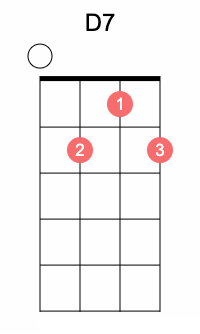Our quick guide where we teach you the basics of baritone uke chords, how to learn some simple patterns and get strumming!
Written by Jay Searle / Published February 2, 2024
Last updated: February 21, 2024

As the second largest instrument in the ukulele family, the baritone typically uses a different tuning compared to its smaller counterparts. Consequently, this means that baritone uke chords will be played a bit differently as they use different shapes to standard ukulele chords.
Before diving into beginner chords, we believe it’s important to understand the basic concepts of baritone chord play with a bit of simplified music theory 101.
Standard Baritone Uke Tuning: D-G-B-E
Baritone ukes have a larger scale length, larger bodies, and larger strings than sopranos, concert, and tenor ukuleles. This means that they sound, play, and feel a lot different relative to smaller ukuleles.
Baritones are typically tuned in the same fashion as the thinnest four strings on standard acoustic guitars, although with the right strings, it is possible to go with the classic GCEA ukulele tuning.
In this article, we’ll be focussing on the more popular DGBE tuning.
Fretting on a Baritone Ukulele
The frets are usually a bit wider on a baritone ukulele, which means two things. First, pressing individual notes is much easier, especially for players with shorter fingers. Secondly, fretting chords might be more difficult since frets are further apart.
To efficiently play baritone chords, it is recommended that you try and practice playing arpeggiated chords first. This means playing each chord one note at a time using individual fingers. Arpeggiating chords is a great way to learn the shapes and also to build finger dexterity and flexibility for accurate chord playing.

Fingerstyle Ukulele or Playing with a Pick?
If you’re transitioning to a baritone from a soprano, tenor, or concert, you’ll probably notice that the strings are somewhat thicker. Even though ukuleles are traditionally played fingerstyle, beginners who are struggling to play chords by plucking the strings or strumming with their nails might want to consider using a regular guitar pick.
Do note though that picks tend to produce a ‘harsher’ sound when striking the strings. If you want to fully embrace the warmth of the ukulele then we recommend practicing with using your fingers.
Easy Baritone Ukulele Chords for Beginners
Over 350+ baritone ukulele chord combinations exist, but most of them are little more than variations of a number of basic chords. Below you’ll find detailed descriptions and illustrations of beginner friendly baritone chords, so let’s dive in.
A Major Baritone Uke Chord

The A Major chord is a remarkably simple combination of notes A, C#, and E. Thanks to the wider frets on a baritone, you’ll be able to fret it accurately with your index, middle, and ring finger if you’re still not confident in your bar chord skills. To play the A Chord, just follow these steps:
- E: Open
- B: Ring finger on the second fret
- G: Middle finger on the second fret
- D: Index finger on the second fret
The most common variations of the A chord are A Minor and A7 chords, both of which are great chords to know for beginners.


To play the A Minor chord, simply move the C# on the second fret of the B string to the C note on the first fret of the B string. You will need to re-arrange your fingers as shown but the position shouldn’t feel too awkward for your left hand.
The easiest way to pull off the A7 chord is to form a bar chord over the D, G and B strings at the second fret with your index finger. You can then fret the G note on the E string with your middle or ring finger, whichever is more comfortable.
B Minor Baritone Uke Chord

B Minor is a staple chord in the majority of tunes with nostalgic or melancholic themes. What makes it so easy to play is the so-called “staircase” shape descending from the note F# to D and ending with B. Follow these steps to play the Bm Chord:
- E: Index finger on the second fret
- B: Middle finger on the third fret
- G: Ring finger on the fourth fret
- D: none
A great sounding chord that is an embellishment of the Bm chord is Bm7 (or B Minor 7th). The addition of the minor 7 interval adds a touch of color to the chord and sounds great in jazzier contexts. Feel free to experiment with the sound and see what works for you.

Playing Bm7 can be just a bit tricky for beginners since there are two fretted and two open notes involved. The simplest way to play it is to fret the A note on the G string with your index finger and fret the F# note on the high E string with your middle finger.
D Dominant 7 Baritone Uke Chord

D7 (or dominant 7) might sound complex, but it’s a fairly straightforward, beginner-friendly chord. The fingering basically mirrors that of a regular D major chord, which is just a touch easier to play in our opinion. It may take a little while to get your fingers used to the D7 shape, but it is an incredibly useful chord to know, especially if you’re playing a song in the key of G major.
- E: Ring finger on the second fret
- B: Index finger on the first fret
- G:Middle finger on the second fret
- D: none
Some other great ‘D chords’ to learn on the baritone are regular D major and D minor, so let’s have a look at how to play them:


D major, as mentioned above, is basically the mirror image of D7 finger position-wise. It’s an incredibly useful chord to know and if playing in the key of G major you can alternate between it and D7. To play it, place your index finger on the second fret of the G string, your ring finger on the third fret of the B string, and your middle finger on the second fret of the E string. Allow the D string to ring out when you strum it.
D minor is the ‘sad’ version of the D chord and only requires you to swap two fingers around when compared to the major chord. Your ring finger stays in the same position as its only your index and middle fingers that change. Move your middle finger from the second fret on the E string to the second fret on the G string. Then, use your index finger to play the F note at the first fret of the E string.
G Major Baritone Ukulele Chord

Even simpler than the A Chord, the G Chord requires you to press the G note on the E string with whichever finger is available in your current chord progression. Leave the strings D, G, and B open, and strum:
- E: Ring/Middle/Index finger on the third fret
- B: Open
- G: Open
- D: Open
If you feel like adding a little bit of tonal color to the G chord without having to alter too much in the way of fingerings, then try playing the G major 7th chord (Gmaj7). Simply move the fretted note in the G major chord down a fret to the second fret as shown below. Again, you can use any finger you like.

C Chord and CMaj7 on Baritone Ukulele

Popularly used in bridges, breakdowns, and outros, the C chord is one of the most important baritone ukulele chords that you should prioritize learning. Follow these steps to play it:
- E: Open
- B: Index finger on the first fret
- G: Open
- D: Middle finger on the second fret
Again, adding the major seventh interval to a C major chord can really add some color and liven up your progressions. Here’s how to play the Cmaj7:

Looks tricky, but keep practicing and you’ll get it down. To play it, place your index finger on the first fret of the B string, your middle finger on the second fret of the D string and your ring figer on the third fret of the E string. The pinky is usually what causes issues with this chord shape due to the stretch. It frets the B note (the 7 in Cmaj7) on the fourth fret of the G string. Try playing each note individually to get your fingers used to the positions as you’re learning the chord.
Simple Chord Progressions & Final Words
The great thing about most of the ukulele chords we’ve covered us that many of them reside in the key of G major. You can simply play around with the order to come up with some cool progressions of your own. Feel free to experiment with sounds by throwing in some of the other chords in too. There’s nothing stopping you from playing Bm7 next to A7 if you want, whatever sounds good to you.
As a basic starting point, the chords of G major, C major and D major sound the most consonant together. Substituting D major for D7 adds a bit of color and sounds great when followed by a G chord. An example progression could therefore be G-C-Em-D7-G.
Once you’re comfortable with these chords, feel free to use our beginner baritone uke chord chart to learn more exciting chords and really open the door to some cool progressions!

Jay Searle
Website Founder & WriterJay is a self-professed music nerd and ukulele lover. When not working on the website you’ll find him strumming along to his favorite tunes, spending time with his family, or learning to play the piano.





